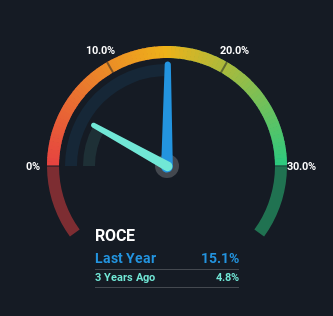- China
- /
- Auto Components
- /
- SHSE:688612
Shenzhen VMAX New Energy (SHSE:688612) Has More To Do To Multiply In Value Going Forward
If we want to find a stock that could multiply over the long term, what are the underlying trends we should look for? Firstly, we'll want to see a proven return on capital employed (ROCE) that is increasing, and secondly, an expanding base of capital employed. Basically this means that a company has profitable initiatives that it can continue to reinvest in, which is a trait of a compounding machine. That's why when we briefly looked at Shenzhen VMAX New Energy's (SHSE:688612) ROCE trend, we were pretty happy with what we saw.
Return On Capital Employed (ROCE): What Is It?
For those that aren't sure what ROCE is, it measures the amount of pre-tax profits a company can generate from the capital employed in its business. To calculate this metric for Shenzhen VMAX New Energy, this is the formula:
Return on Capital Employed = Earnings Before Interest and Tax (EBIT) ÷ (Total Assets - Current Liabilities)
0.15 = CN¥584m ÷ (CN¥7.2b - CN¥3.3b) (Based on the trailing twelve months to March 2024).
Therefore, Shenzhen VMAX New Energy has an ROCE of 15%. In absolute terms, that's a satisfactory return, but compared to the Auto Components industry average of 6.9% it's much better.
Check out our latest analysis for Shenzhen VMAX New Energy

Above you can see how the current ROCE for Shenzhen VMAX New Energy compares to its prior returns on capital, but there's only so much you can tell from the past. If you'd like, you can check out the forecasts from the analysts covering Shenzhen VMAX New Energy for free.
What Can We Tell From Shenzhen VMAX New Energy's ROCE Trend?
While the current returns on capital are decent, they haven't changed much. Over the past five years, ROCE has remained relatively flat at around 15% and the business has deployed 989% more capital into its operations. Since 15% is a moderate ROCE though, it's good to see a business can continue to reinvest at these decent rates of return. Over long periods of time, returns like these might not be too exciting, but with consistency they can pay off in terms of share price returns.
On a separate but related note, it's important to know that Shenzhen VMAX New Energy has a current liabilities to total assets ratio of 46%, which we'd consider pretty high. This can bring about some risks because the company is basically operating with a rather large reliance on its suppliers or other sorts of short-term creditors. While it's not necessarily a bad thing, it can be beneficial if this ratio is lower.
Our Take On Shenzhen VMAX New Energy's ROCE
In the end, Shenzhen VMAX New Energy has proven its ability to adequately reinvest capital at good rates of return. Yet over the last year the stock has declined 56%, so the decline might provide an opening. For that reason, savvy investors might want to look further into this company in case it's a prime investment.
Since virtually every company faces some risks, it's worth knowing what they are, and we've spotted 2 warning signs for Shenzhen VMAX New Energy (of which 1 can't be ignored!) that you should know about.
If you want to search for solid companies with great earnings, check out this free list of companies with good balance sheets and impressive returns on equity.
New: Manage All Your Stock Portfolios in One Place
We've created the ultimate portfolio companion for stock investors, and it's free.
• Connect an unlimited number of Portfolios and see your total in one currency
• Be alerted to new Warning Signs or Risks via email or mobile
• Track the Fair Value of your stocks
Have feedback on this article? Concerned about the content? Get in touch with us directly. Alternatively, email editorial-team (at) simplywallst.com.
This article by Simply Wall St is general in nature. We provide commentary based on historical data and analyst forecasts only using an unbiased methodology and our articles are not intended to be financial advice. It does not constitute a recommendation to buy or sell any stock, and does not take account of your objectives, or your financial situation. We aim to bring you long-term focused analysis driven by fundamental data. Note that our analysis may not factor in the latest price-sensitive company announcements or qualitative material. Simply Wall St has no position in any stocks mentioned.
Have feedback on this article? Concerned about the content? Get in touch with us directly. Alternatively, email editorial-team@simplywallst.com
About SHSE:688612
Shenzhen VMAX New Energy
Engages in the research, development, production, and sale and technical services of new energy vehicle power products in China and internationally.
Exceptional growth potential with flawless balance sheet and pays a dividend.
Market Insights
Community Narratives



